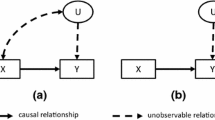Abstract
In this chapter, we focus on the person side of the logistic mixed model. As described in Chapter 2, the simple Rasch model can be extended by including person characteristics as predictors. The resulting models can be called latent regression models, since the latent person abilities (the θs) are regressed on person characteristics. A special kind of a person characteristic is a person group: for instance, pupils can be grouped in schools. Then there are two possibilities for modeling, either we can define random school effects, or we can utilize school indicators with fixed effects.
Access this chapter
Tax calculation will be finalised at checkout
Purchases are for personal use only
Preview
Unable to display preview. Download preview PDF.
Similar content being viewed by others
References
Adams, R.J., Wilson, M., & Wu, M. (1997). Multilevel item response models: An approach to errors in variables regression. Journal of Educational and Behavioral Statistics, 22, 47–76.
Bock, R.D., & Aitkin, M. (1981). Marginal maximum likelihood estimation of item parameters: Application of an EM algorithm. Psychometrika, 46, 443–459.
Breslow, N.E., & Clayton, D.G. (1993). Approximate inference in generalized linear mixed models. Journal of the American Statistical Association, 88, 9–25.
Bryk, A.S., Raudenbush, S.W., & Congdon, R.T. (1996). ELM: Hierarchical Linear and Non-linear Modeling with the HLM/2L and HLM/3L Programs. Chicago, IL: Scientific Software.
Goldstein, H. (1987a). Multilevel covariance components models. Biometrika, 74, 430–431.
Goldstein, H. (1987b). Multilevel Models in Educational and Social Research. London: Griffin.
Goldstein, H. (2003). Multilevel Statistical Models (3rd ed.). London: Arnold.
Goldstein, H., Rasbash, J., Plewis, I., Draper, D., Browne, W., Yang, M., Woodhouse, G., & Healy, M. (1998). A User’s Guide to MLwiN. Multilevel Project, University of London.
Hox, J. (2002). Multilevel Analysis. Techniques and Applications. Mahwah, NJ: Lawrence Erlbaum.
Kamata, A. (2001). Item analysis by the hierarchical generalized linear model. Journal of Educational Measurement, 38, 79–93.
Longford, N.T. (1993). Random Coefficient Models. Oxford: Clarendon Press.
McCullagh, P., & Neider, J. A. (1989). Generalized Linear Models (2nd ed.). London: Chapman & Hall.
Raudenbush, S.W. (1988). Educational applications of hierarchical linear models: A review. Journal of Educational Statistics, 13, 85–116.
Raudenbush, S.W. (1993). A crossed random effects models for unbalanced data with applications in cross-sectional and longitudinal research. Journal of Educational Statistics, 18, 321–349.
Raudenbush, S.W., & Bryk, A.S. (2002). Hierarchical Linear Models: Applications and Data Analysis Methods (2nd ed.). London: Sage.
Raudenbush, S.W., & Sampson, R. (1999). Assessing direct and indirect effects in multilevel designs with latent variables. Sociological Methods & Research, 28, 123–153.
Rijmen, F., Tuerlinkx, F., De Boeck, P., & Kuppens (2003). A nonlinear mixed model framework for item response theory. Psychological Methods, 8, 185–205.
Snijders, T.A.B., & Bosker, R.J. (1999). Multilevel Analysis. An Introduction to Basic and Advanced Multilevel Modeling. London: Sage.
Spielberger, C.D. (1988). State-Trait Anger Expression Inventory Research Edition. Professional Manual. Odessa, FL: Psychological Assessment Resources.
Van den Noortgate, W., De Boeck, P., Meulders, M. (2003). Cross-classification multilevel logistic models in psychometrics. Journal of Educational and Behavioral Statistics. Manuscript accepted for publication.
Wolfinger, R., & O’Connell, M. (1993). Generalized linear mixed models: A pseudo-likelihood approach. Journal of Statistical Computation and Simulation, 48, 233–243.
Editor information
Editors and Affiliations
Rights and permissions
Copyright information
© 2004 Springer Science+Business Media New York
About this chapter
Cite this chapter
Van den Noortgate, W., Paek, I. (2004). Person regression models. In: De Boeck, P., Wilson, M. (eds) Explanatory Item Response Models. Statistics for Social Science and Public Policy. Springer, New York, NY. https://doi.org/10.1007/978-1-4757-3990-9_5
Download citation
DOI: https://doi.org/10.1007/978-1-4757-3990-9_5
Publisher Name: Springer, New York, NY
Print ISBN: 978-1-4419-2323-3
Online ISBN: 978-1-4757-3990-9
eBook Packages: Springer Book Archive




